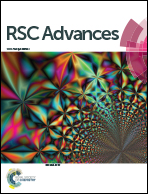Computational screening of transition-metal doped boron nanotubes as efficient electrocatalysts for water splitting†
Abstract
The search for efficient and low-cost electrocatalysts for the oxygen evolution reaction (OER) and the hydrogen evolution reaction (HER) is of utmost importance for the production of hydrogen and oxygen via water splitting. In this work, the catalytic performance of the OER and HER on transition metal doped boron nanotubes (BNTs) was investigated using density functional theory. It was found that the doped transition metal atoms determine the catalytic activity of the BNTs. Rhodium-doped BNTs exhibited excellent OER activity, while cobalt-doped BNTs displayed great catalytic activity toward the HER. Volcano relationships were found between the catalytic activity and the adsorption strength of reaction intermediates. Rhodium- and cobalt-doped BNTs exhibited great OER and HER catalytic activity due to the favorable adsorption strength of reaction intermediates. This work sheds light on the design of novel electrocatalysts for water splitting and provides helpful guidelines for the future development of advanced electrocatalysts.



 Please wait while we load your content...
Please wait while we load your content...